#why would you make a manga adaption of a game that's largely driven by a self-insert-style main character
Explore tagged Tumblr posts
Text
y'all have no clue how wild it is to live in my timeline, because 12 years ago i was a huge fan of these cute lil' zelda strips and at the time i found out through the grapevine that the creator apparently stopped making these comics because they had started drawing NSFW content-
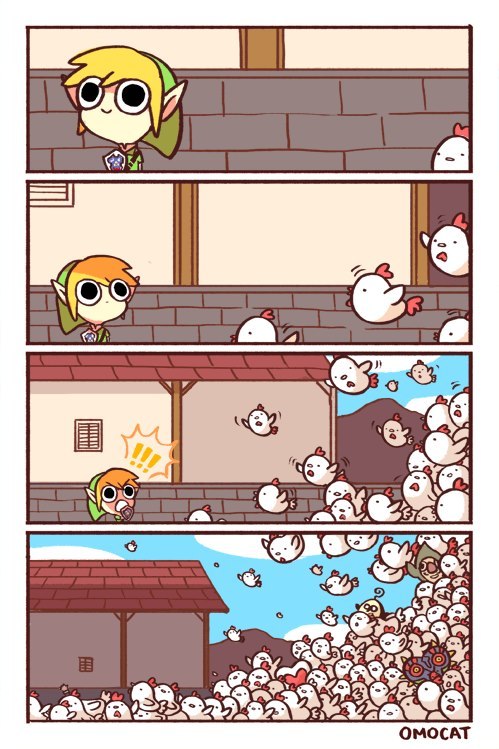
and at the time i was like "oh ok that's wild but respect"
and now in the present the artist who's making the OMORI manga adaption is under fire for being a shota fetishist and it's putting the spotlight back on the OMORI creator themselves for ALSO being a shota fetishist and oh my god the omocat who made those zelda comics over a decade ago is the same omocat who went on to make OMORI holy shit-
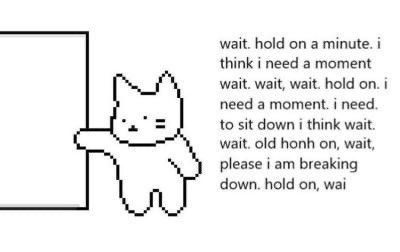
#small fucking world jfc#and yeah maybe i'm the last person to cross the finish line here but listen#i hadn't thought about those zelda comics in AGES#not until i came across one of them in my FB memories#because i've been on FB so long now that some of my memories are like 15 years old#and as soon as i saw the artist credit i was like HOLD the fucking phone there's no WAY#anyways there's some wild shit happening in the omori fandom ig#i've only completed the whole game once and honestly i loved it but i haven't really participated in the greater fandom#and i can very much see what people are getting at lmao#especially with the manga jfc#why would you make a manga adaption of a game that's largely driven by a self-insert-style main character#never mind the fact that it completely removes the soundtrack which is like half of what made omori so memorable ffs#even without the shota shit a manga version of OMORI is still. just not something we needed lmao#bad dumb stupid idea
119 notes
·
View notes
Text
Dante, and Vergil’s Impact on His Character Arc
I’ve been a long-time casual fan of the Devil May Cry games, though my skills at them are woefully inadequate. I’m more a fan of the crazy action that the series strives to provide in each of its entries and the wonderful misadventures Dante keeps getting dragged into, to say nothing of watching in awe high-level players pulling off combos so wild and energetic that they add years to my life expectancy.
But while it’s never been a main draw to the series, I feel like Devil May Cry is, at its best, a series that does manage to generate enrapturing characters and create fluid arcs across its games, and I feel that this comes across in what might go down as the greatest unintentional character arc in gaming, that of Dante.
While Dante in the first two games didn’t have much character, especially in DMC2, Devil May Cry 3 is when Dante’s characterization was finally solidified, not least of which because of the vocal talents of Reuben Langdon being added to Dante that gave him so much character across his future appearances. It’s not an exaggeration to say Dante is one of the most well-received and iconic protagonists in modern gaming, and I think that was solidifed thanks to the work of Itsuno, the Capcom team and Langdon in DMC3. What also helped was the introduction and solidification of Dante’s relationship with his brother, Vergil. This relationship has gone on to have major impacts on Dante’s character not just across DMC 4 and 5, but also in retrospect allows for Dante to develop an arc through DMCs 1, 2 and even the Animated Series.
As such, in this essay I’d like to look at Dante’s character across all five main Devil May Cry games, in particular focusing on his relationship with Vergil and how it impacted him across his life. Please note this essay will contain spoilers for Devil May Cry 5.
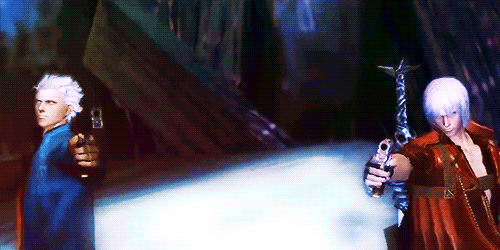
1) Pre-series and 3
Dante was born alongside his twin brother Vergil to Sparda and Eva, a demon who woke up to justice and sought to defend humanity from his demonic kin and a human woman who he fell in love with. The boys before they were eight were granted two halves of the Perfect Amulet, which when combined could open the path to the demon world. Sparda would die of unknown circumstances when the boys were young, and when Dante was 8, the family home was attacked by demons. Eva hid Dante away in a closet, telling him that if she died, he was to escape and assume a new identity. Eva went on to die trying to find Vergil (Dante assumes he is dead as well), with her death shaping Dante and Vergil into the men would become later in life- Dante would swear vengeance on all demons, while Vergil would develop the mindset that had he been more powerful, he could have prevented Eva’s death, which would cause him to seek out Sparda’s sword, Force Edge.
While growing up, Dante has become a freelance mercenary operating under the name of Tony Redgrave. Before the games, he spent time working with Enzo Ferino, who would pass along jobs to Dante, and Nell Goldstein, a gunsmith who made Dante’s signature pistols, Ebony and Ivory. Dante in a manga set right before 3 has learned that Vergil survived the attack on the Sparda Manor, and while he is initially ecstatic to learn of Vergil’s survival, the two quickly realize that they are both driven to accomplish goals that the other would get in the way of. Vergil defeats Dante in a duel, but lets him keep his half of the Perfect Amulet.
When 3 starts, it’s been a year since their first meeting. Dante is 19 and has nearly finished work on his new office, determined to follow the phrase “If you’re good at something don’t do it for free” to the logical conclusion in making demon hunting his job. After a mysterious man named Arkham offers Dante a chance to see Vergil at the top of a tower that arises from the earth named Temen-ni-gru, Dante sets out to confront Vergil and have an “interesting time” fighting the demons along the way. Vergil meanwhile, is drawing Dante to Temen-ni-gru to acquire Dante’s half of the Amulet and acquire the powers of Sparda hidden within, along with Sparda’s blade Force Edge.
Dante doesn’t take the whole affair seriously at all at first, joking all the way up to his first meeting with Vergil that this will all be a large party- and that the lack of food, drinks and women shows that Vergil knows how to throw a stinker of a party. Vergil takes the jokes in stride and even makes one in return, apologizing to Dante since he was so eager to see Dante, he “couldn’t concentrate on preparations for the bash.” Dante is quick to make a fight out of the conflict, drawing a gun on Vergil which... goes well for Dante.
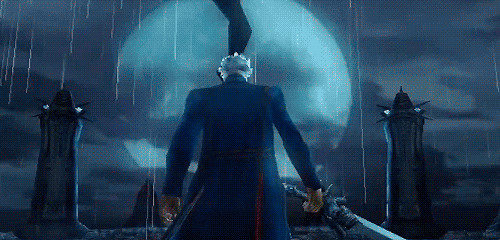
It probably shows how bad Dante’s day is going when this isn’t even the first time today he’s been run through the chest.
Vergil slaughters Dante in their first fight, showing a complete lack of regard for any of Dante’s attacks. This attitude reflects into gameplay as well- Vergil is a challenging boss fight this early in the game and will defeat you if you drop your guard for even a second, forcing you to adapt to his fighting style and making it so you can’t just spam the same tricks over and over. There is a deliberate power imbalance between Dante and Vergil in their first fight, and Vergil even angrily calls Dante on refusing to tap into his demonic power. Dante’s blithe response that “I have no father,” and that he’s not tapping into his power just to spite Vergil only further enrages Vergil, and he wastes not time winning the battle by running Dante through- first with Yamato, then with Dante’s own sword Rebellion.
Vergil gives a look into his mindset here as he talks down to Dante. "Might controls everything. Without strength, you can't protect anything... Let alone yourself." It’s a look into Vergil’s psyche that shows that just like Dante, he never got over Eva’s death and likely why he’s never formed a serious relationship beyond a one-night-stand in Fortuna. It’s almost like Vergil’s afraid of opening up his heart in case it gets broken again. But yet it’s in him running Dante through that he forces the lesson onto Dante- that Dante will not be able to overcome the remaining trials in his way without tapping into the power granted through Sparda’s blood in his veins. And as such after reclaiming Rebellion, Dante forcibly triggers his Devil Trigger for the first time, embracing the demonic monster he had spent years rejecting.
This is Dante’s lowest point in the game- ironic given how this happens at the top of the tower. He has no allies, he’s lost his amulet and Vergil has made a mockery of him in their first duel. But slowly, Dante gets back up and steels himself for round 2, punching a pillar in frustration only to watch as his energy causes it to explode from the force. And upon realizing the power he now wields, Dante cuts loose in a glorious cutscene showing his drive and refusal to give in as he freefalls down the side of the tower and defeats a swarm of enemies, all while Devils Never Cry kicks into high gear.

Bless me with your gift of light Righteous cause on judgment night Feel the sorrow the light has swallowed Feel the freedom like no tomorrow
From this point on, DMC3 shifts focus and becomes a race between Dante and Vergil to see who can uncover the secrets of the tower and unlock Sparda’s power first, both unaware that they and Lady, a human woman trying to hunt down her father, that Arkham is playing everyone so that he can swoop in and steal Sparda’s power at the last second.
Dante and Vergil fight again fight after Vergil has unlocked the last barrier holding back Sparda’s power. Along the way Dante slowly comes to terms with his demonic heritage and learns to embrace its power more, all while Vergil rejects his humanity, believing that true strength will come from the power of a demon. What Vergil doesn’t know however is that Devil May Cry’s humanity possess a power that no demon could ever dream of possessing- something Vergil learns the hard way in 3 and 5, while Dante rubs it in Agnus’s face in 4. Devil May Cry 1 director Hideki Kamiya would eventually confirm on Twitter that what humans possess is simple- heart. The heart to get back up after a crippling defeat and prepare for round 2, or to simply never accept defeat, is in fact one of Dante’s greatest weapons, greater even than his sword, guns or electric bat guitar.
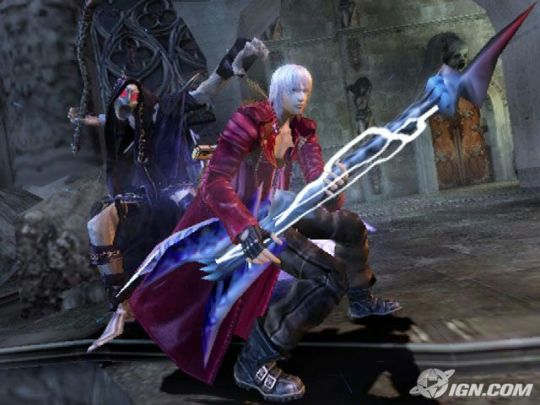
... Man Devil May Cry 3 gets weird and I love it.
It’s through using his heart along with his demonic powers that Dante is able to grow as a fighter, represented in-game as the player not just upgrading Dante’s styles and weapons, but becoming better with the tools provided and taking the time to become more stylish and visually exciting with each new fight being an opportunity to pull of a new stylish combo.
Dante’s second battle with Vergil occurs in the basement of the tower, with the fight ending in a draw as before either can strike a finishing blow, Lady and subsequently Arkham intervene in the fight, Arkham having planned for Dante and Vergil to wear themselves out fighting each other so that neither of them had the power to stop him from stealing Sparda’s power for himself. And despite being a lowly human, Arkham is able to play Dante, Lady and Vergil like chess pieces and take the power of Sparda for himself, before the power mutates him into a giant blob monster that threatens the world.
Vergil disappears for much of the rest of the game as Dante races after Arkham to stop him, defeating several more demons within and absorbing their energy to create more Devil Arms (alongside taking Beowulf off Vergil after he dropped it). Dante initially fights Arkham alone, but even as a giant blob Arkham proves a significant threat to Dante until Vergil offers some backup. Putting aside their mutual differences, the two brothers decide to honor their father by beating the ever-living crap out of the man who stole his power, delivering the finishing blow through a combined Ebony and Ivory shot while saying Dante’s signature line.
youtube
A moment so good I had to include it twice
It’s also notable that this is the one time Vergil gets over his aversion to firearms-

I’m sorry DID I STUTTER
After Arkham is defeated and sent away for Lady to deliver the killing blow on, there’s a moment of silence between Dante and Vergil. The Jackpot scene and its immediate aftermath really does sum up a lot of their relationship- they may have been fighting almost every time we’ve seen them thus fat, and there is genuine aminosity between the two, but Dante and Vergil are ultimately just brothers who ultimately respect each other and might have even been more permanent allies were it not for their ideological differences... differences which directly cause the game’s final boss.
Vergil dives in after the Perfect Amulet, landing on the edge of the Demon World itself with Dante in hot pursuit. Vergil bluntly orders Dante to give him his half of the amulet, and when Dante refuses to and challenges Vergil on what he’ll do with the power, Vergil snaps at him, charging with his newly acquired Force Edge. Dante has none of it, catching the sword and insisting that his soul is saying it wants to stop Vergil. It’s disheartening that both brothers come to blows so soon after their effective teamup, but neither of them will compromise on their goals.
Vergil’s final fight is a perfect climax of the game, both emotionally and mechanically. As Dante and Vergil keep fighting, two facts remain the same- the location of the fight is geographically lower and lower each time, and Dante gets better with each bout, losing in the first round, drawing with Vergil in the second and in the third, after having embraced Sparda’s heritage, coming ahead of Vergil and winning conclusively. It’s still a difficult bout for the player but after all their time in this hellish night with Dante, you’ve mastered the game and are able to meet Vergil beat for beat.
Dante wins the final clash of swords, with Vergil stubbornly refusing to accept defeat and hand over his half of the amulet. He encourages Dante to leave him in the Demon World, before letting himself fall of the side in an effective suicide. Dante tries to reach out to him, but Vergil slashes open his hand as he falls, bringing his half of the amulet with him. Dante doesn’t say a word for the rest of the scene, but his face and body language betray how emotionally compromised he’s become by Vergil’s loss. He glumly brings Force Edge with him to the surface and meets up with Lady, whose attempts to lift Dante’s spirits coin the name of the series- “Maybe somewhere out there, even a devil may cry when he loses a love one.” Even though it does lift Dante’s spirits and gives him a name for his shop, Vergil’s suicide haunts Dante for years, and the first signs of it are present even in the ending of DMC3, where his final taunt before the credtis fight scene sounds like he’s trying to convince himself that he’s ready to take everything the world can throw at him.
In a post-credits scene, Vergil squares off against DMC1′s main villain Mundus. Vergil cockily decides to take him on, but the results of the battle were already known in DMC1, where Dante fights Vergil as Nelo Angelo.
2) DMC 1, 2 and Animated Series- Depressed Dante
In advance, I am going to say this: obviously enough, DMC 1 and 2 were written before DMC 3 and any attempts I make at retroactively making 3′s narrative tie into both of them is weakened as a consequence as it falls into headcanons more often then not. Being blunt, DMC 1 and 2 didn’t have as much focus on story as 3 so any attempts I make to connect their stories might come off as trying to connect threads while wearing cooking gloves. Just keep that in mind for this part barring anything I say on the anime.
Nine years after the Temen-Ni-Gru incident, Dante has set up Devil May Cry and takes extermination jobs for anyone who calls his shop with the elusive password. While he’s making dry quips and nonchalantly dealing with the threats he faces while fighting Mundus, he’s notably less energetic compared to his younger self. Dante is more somber and reflective almost as a direct consequence of his dealings with Vergil, and while he’s still cracking wise when he confronts the demons Mundus has scattered around the island, he’s far less talkative than he was. One of his more talkative moments comes after Mundus kills Griffon, who had genuinely earned Dante’s respect through their repeated encounters across the game. Dante is quite livid at Mundus killing one of his own soldiers in such a callous way, as he tells Trish:
“Mundus... His heinous ways make me sick; killing his own like they were nothing. He's the one that took the life of my mother for sure. My mother always used to tell me that my father was a man who fought for the weak. He had courage and a righteous heart. In the name of my father I will kill Mundus!"
Dante has an unexpected family reunion when he fights Vergil, covered in armor, as Nelo Angelo several times over the story. Nelo Angelo provides some of the tougher fights in DMC1, managing to disarm Dante during their first bout and neatly delivering a killing blow before Nelo spots Dante’s amulet and retreats, as if Vergil refuses to give Mundus the satisfaction of having Vergil kill Dante for him. Dante admits grudging respect for Nelo Angelo, saying he didn’t expect to find anyone with “guts and honor” in the castle.
Their second battle sees Nelo removing his helmet, revealing Vergil’s corrupted visage underneath. Despite the enhancement of the armor, Vergil loses again to Dante, this time seemingly dying as he explodes in a flash of lightning, leaving nothing but Vergil’s half of the Perfect Amulet. Dante stops to recollect a childhood memory of himself and Vergil wanting cake for their birthday, before combining the amulets and using it to reawaken Sparda and have it resume its true power.
The rest of DMC 1 has Dante suffer from Trish’s betrayal and subsequent redemption, but while he ends the game on a victorious note after having beaten Mundus and saved Trish with a variation of Lady’s line to him, he’s also despondent at the loss of Vergil yet again, which leads to Dante being more sullen in the animated series and DMC2, which both take place five years later when Dante is 33.
Dante’s characterization in the DMC Animated Series is often considered divisive due to him being rather mellow and sullen compared to his more distinctive appearances, especially since Reuben actually provided Dante’s voice under a false name. However, intentionally or not, Dante’s characterization in the anime bears a lot of symptoms consistent with depression: Dante is even more of a slob than normal, frequently is tired and sleeps all day, eats only comfort food (strawberry sundaes in the show) and only ever comes alive while working. But since Dante is so powerful in the anime, he’s lucky if a fight lasts more than a few seconds. When looking at the anime in the context of DMCs 1 and 3, it gives the impression that Dante is just worn down after losing Vergil in 3, only to then kill him in 1. This leaves Dante as the last member of his bloodline, which drags him down. Fortunately, Dante has Lady and Trish to keep dragging him out of bed and getting him to care, and he seems to slowly be recovering from his depression by the time of DMC2.
Devil May Cry 2 has no real plot and Dante has been stripped of almost all the characterization in 1 and 3 which made him such an iconic character. Like nearly everything else wrong with DMC 2, this largely comes down to the disaster of a development cycle that the game had- director Hideaki Itsuno admitted in an art book that when he was brought on to direct DMC 2, he was replacing a director who had botched the project so hard that Itsuno only had four months to essentially develop the entire game, including the script. As such, Dante’s character is very flat. Barring one line (“King? Here’s your crown.”), Dante has no memorable quips or dialogue, with most of the development being handed off to Lucia instead. Dante’s one significant character trait is his habit of flipping a coin to choose events for him, a trait that has rarely been acknowledged since. While this Dante does fall into the line of thinking we’ve used so far, that Dante is suffering from depression for much of his late 20s and early 30s, it’s hard to even consider this as a possibility when Dante’s stoic nature is just because of a rushed script and weak writing, and it feels almost dirty to try and tie in the depression theory to this.
Thankfully, Dante’s character would like much of the series get an extended redemption thanks to DMC3, but the next entry in the timeline put him back on track..
3) DMC 4 and the reclamation of hope
For a long time, DMC 2 was the final point in the timeline, in part because of Capcom’s shame for the game being so great that they are actively reluctant to acknowledge the existence of DMC2. Before DMC 5 released, Executive Producer Matt Walker confirmed that the timeline had been changed from 3-1-4-2 to 3-1-2-4, and one of the consequences of this was that Dante’s character arc began to flow naturally.
While there are several scenes in DMC4 set before the game begins, most notably the explanation of why Trish gave the Order Sparda’s sword which also leads into the intro cutscene for Trish and Lady’s route in Special Edition, a long-standing fan theory is that Dante begins DMC4 with some vestiges of his Anime/2 depression remaining, hence why he fails to exhibit any of his typical stylish moves during his assassination attempt on Sanctus- he just jumps down the window and shoots him point-blank in the head. It’s only when Nero attacks him and subsequently lasts longer than most of the Order guards that Dante begins to treat the fight with his usual charm. It’s made clear that he’s not taking the battle against Nero too seriously, and it’s evident that if Dante wanted he could turn Nero into a smear on the pavement in a heartbeat. But the Devil Bringer, along with Nero’s refusal to let Dante get away, impress Dante enough to let Nero go, which leads to Nero spending much of his route hunting Dante down until the two finally meet again and have a rematch at Fortuna Castle.
Even with his new upgrades, including Vergil’s sword Yamato and his new Devil Trigger, Nero is barely able to keep up with Dante, who in gameplay is a nightmare to fight due to having access to all four of his DMC 3 styles at will and being played by an AI seemingly designed to wreck your day. To little surprise, Nero loses and is disarmed of Yamato. Dante is eager to reclaim Yamato, telling Nero “It belongs in the family,” but chooses to let Nero keep hold of Yamato for now due to having become less hot-headed and wanting to use the weapon to help save Kyrie. However, Sanctus is revealed to have been revived and traps Nero in the Savior (an artificial demon the Order created that requires Sparda’s blood and sword) before it marches on Fortuna City with Yamato. Dante races back through the route Nero took, determined to reclaim Yamato and destroy the Savior.
Dante doesn’t develop much during his playable segment of the game, barring the new Devil Arm cutscenes confirming that he is back to his usual jovial and eccentric self. Much like with Nero, Dante’s power means that the threat of the Savior is quite small in the grand scheme- Dante can defeat it in a head to head fight and the story doesn’t try to convince you that this threat can top the one presented by Mundus. Dante eventually returns to Fortuna and after confronting Agnus in one of the greatest cutscenes in human history, reclaims his brother’s sword and then frees Nero. Between the two of them tag-teaming the Savior and Sanctus from the inside and out, Dante and Nero bring a stop to the Order’s plans and destroy the Savior, Dante reclaiming his father’s sword.
With that, Dante leaves, job complete. Nero confusedly asks if Dante wants Yamato back, but Dante blithely tells him to keep it, confident in Nero’s abilities now as a Devil Hunter.
Nero: "What...? I thought this meant a lot to you...?" Dante: "That's the only kind of gift worth giving. I want to entrust it to you, and so I am. What you do from here is your call."
Deadly Fortune (the Japanese only DMC 4 novelization) and DMC 5 would go on to confirm that Dante allowed Nero to set up a new branch of Devil May Cry in Fortuna. Nero asks Dante if they’ll meet again, but Dante only shoots a wave over his shoulder. Little did they know that meeting again would take eleven long years, before they got to join up back together for more hijinks.
youtube
By the end of DMC4, Dante has finally gotten over the trauma and baggage he’s been carrying since Vergil’s death. Seeing the new generation of demon hunters in Nero has reignited the spark that laid dormant inside of him for so long. Dante’s 38 by the time of DMC4, meaning he carried those dark emotions inside him for over half his life, but with Nero wielding Yamato, Dante has finally become able to let go and become the cool uncle/mentor figure Nero needs.
4) DMC 5- Acceptance and peace
... so of course just five short years later, everything goes right back to hell for Dante. He’s still not great at managing the financial side of his business, but the arrival of a mysterious young man named V with a promised contract that will provide cash up front gives Dante all the drive he needs to get into gear to confront Urizen. But unfortunately, Urizen proves far stronger than anyone feared, and he effortlessly defeats Dante, Trish, Lady and a late to the party Nero who lost his Devil Bringer two weeks prior. Dante, desperate, breaks out his Devil Trigger and orders V to get Nero out of there, deriding Nero as “dead weight.” Soon after, Urizen beats Dante out of Devil Trigger and shatters Rebellion, sending him flying out of the Qliphoth and into a coma for a month.
V eventually finds Dante by the ruins of an old manor, the demons having not found him because of the Devil Arm Sparda having hidden Dante’s presence. After a little fakeout stab, Dante is restored to fighting form and immediately goes to get ready for Round 2 with Urizen, all while Nero, now armed with the Devil Breakers, desperately tries to kill Urizen himself. Dante first gets himself some sick wheels and makes for the ruins of the Sparda Manor where his life got flipped on its head over thirty years prior.
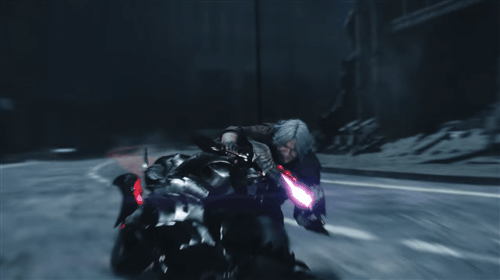
Somehow, this isn’t the craziest weapon in the game.
After lamenting on how he always seems to get a sword through the gut, Dante impales himself on the Rebellion like Virgil did back on the top of Temen-Ni-Gru. And just like then, Dante unlocks a new level to his demonic abilities, gaining the Sin Devil Trigger and a new Devil Arm, the Dante. Armed and ready, Dante makes for Urizen to show him whats what. While Urizen makes a hasty retreat, he is able to supercharge himself with the Qliphoth fruit before Dante arrives, but even this increase in power isn’t enough to stop Dante, because not only has he gained more power through Sin Devil Trigger, but Urizen, just like Vergil, has failed to learn the important lesson of humanity in Devil May Cry.

Side-note, this is the greatest cutscene in the history of video games. I don’t really have any way to tie the Faust Hat to this analysis but I thought we all needed a reminder that this was a glorious thing.
Dante, unlike the audience, has always been aware that Urizen was Vergil or at least his demonic half. Urizen is literally Vergil's ambition and greed manifested into a malevolent, power-hungry demon, and much like Vergil himself, Urizen fails to realize that through sacrificing his human half, he’s lost the true power within himself. It takes until Dante lays the smackdown on Urizen even after being supercharged with the Qliphoth root. In Urizen’s eyes, Dante hasn’t sacrificed anything to achieve this power and fights Urizen simply because it’s the right thing to do, and that desire to protect others
Urizen: How... How are you so powerful?! You never lost anything! Dante: It's not about loss... Strength is a choice! Fighting like hell to protect what matters! You threw away everything you ever had! No wonder you have no true power! Urizen: Danteeeeee!
Ultimately, Dante defeats Urizen and leaves him a dying husk on the ground. But before he can deliver the killing blow, V tricks Dante into letting him finish the job, allowing him to merge with Urizen and become Vergil, brought back from the dead.
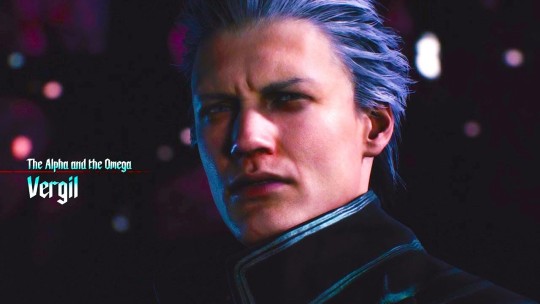
All of the main characters in DMC5 have their own subtitles along with their name when introduced, and Vergil’s is perfectly fitting from a meta angle- he was Dante’s first major opponent in DMC3, and now here he is at the end of the Sons of Sparda saga, the final boss for the last hours of the game.
Dante immediately freaks out at Vergil’s return and goes to kill him, but due to expending so much energy on Urizen, Vergil is able to push him back with ease, telling him to heal his wounds before trying to face him. Dante stubbornly begins climbing back up the Qliphoth, even as Nero tries to dissuade him until Dante tells Nero the truth that Vergil is his father, before pressing on alone and leaving Nero to escape the tree. Dante and Vergil both never even consider the possibility of not fighting to the death. The last time they tried to talk things out at the edge of the Demon world, both Dante and Vergil proved their ideologies were just too different for them to peacefully co-exist. The tragedy of DMC 3′s climax stretches on more than twenty years later for these two, and neither are of the mindset that this can end in any way that’s not one of the twins standing over the other’s body. .
On the way, Dante finds V’s three Summons- Griffon, Shadow and Nightmare- who reveal themselves to be the manifestations of Vergil’s traumatic memories from his time as Nelo Angelo. The familiars force a fight against Dante, warning him that if he can’t beat them he doesn’t stand a chance against Vergil. Though Dante makes no note of it, eliminating the familiars has likely ensured Vergil will be able to live without the trauma from his time under Mundus. Dante is particularly respectful to Griffon, the servant of Mundus who he never got to properly defeat in battle and the one he almost respected. It feels like Dante finally being allowed to have the fair fight with Griffon that the demon deserved more than a decade prior.
Ultimately, Dante makes his way to the top, with both the brothers pausing for a moment to ponder how many times they’ve exchanged blows. Dante even admits that them fighting is the only memories of the two that he can remember since they were children. Ultimately they draw their weapons, and begin their final clash.
It’s ultimately a desperate knockout brawl, with both fighters giving it their all and using everything and anything they’ve learned over the years to gain an edge in the fight, but it ends on a draw with both stopping to catch their breath after a fight that canonically goes on for more than twenty minutes. Vergil finally realizes that Nero is his son. The two stop for a second, Dante gently ribbing Vergil for being young once as well, but even then it loops back around to their deathmatch. Despite both being clearly exhausted, they fire up their Devil Triggers and prepare for another charge, only to be interrupted by a new demon- Nero, having gained the strength to activate his own Devil Trigger and regrow his lost arm, now determined to stop the two twins from killing each other once and for all.
Throughout DMC5, starting with the “Dead Weight” line, Dante has had a habit of disrespecting Nero. Granted, Dante is canonically stronger, but he bluntly tells Nero multiple times that he effectively doesn’t care what Nero thinks of a situation, Dante will do it his way. Yet again he tries to assert dominance over Nero, but this time Nero, now armed with a new Devil Trigger and at the peak of his strength while Dante and Vergil are both exhausted, bitch slaps Dante out of the fight and promises to make Vergil submit to him. Vergil in turn doesn’t take Nero seriously, but promises him a fight when Nero bluntly repeats that neither of the brothers are dying today. What follows is an extended curb stomp as Nero pays Vergil back dividends for ripping off his arm at the start of the game. While Vergil normally wouldn’t be so easily defeated by Nero, his exhaustion from fighting Dante and expending so much energy on maintaining his Devil Trigger have drained him of the stamina he needs and as such, Nero canonically dominates the fight.

This, Ninja Theory, is how you make your protagonist screaming “Fuck you!” look insanely cool and not pathetic
Nero makes Vergil take a knee, but the situation changes from the immediate battle. Dante and Vergil resolve to descend into the Underworld to cut the Qliphoth's roots. When Nero counters that this potentially leaves the two stranded, Dante quietly tells Nero that it’s because of him that they can make this risk. With Nero on this side of the barrier ready to protect humanity, Dante is comfortable potentially trapping himself on the other side of the dimensional border with Vergil. And as such, the two brothers fly into the Underworld and destroy the Qliphoth once and for all, leaving Nero, Lady and Trish to safeguard the human world.
When we next see Dante and Vergil, they’re in the depths of the Underworld. Just like when Vergil lost to Dante in DMC3, he asks Dante to go back to the human world- Vergil wants to atone for Urizen’s sins and that involves ensuring the destruction of the tree. But Dante doesn’t want to leave his brother alone this time, noting that someone needs to keep an eye on Vergil- if only to ensure a repeat of the Nelo Angelo incident doesn’t happen. As Qliphoth tree roots begin to form around Dante and Vergil, we play as Dante one final time in a playable credits sequence.
When we cut back to Dante and Vergil for the final scene, they’re locked in yet another battle. But this time, it’s a friendly spar with no malice or aminosity between them barring normal brotherly bickering. Dante even quips that he’s one up after winning while Vergil counters that Dante miscounted and that they’re even. As they ready for another round, a new wave of demons emerge and without breaking stride, the two begin clearing house. As Vergil snarls at him not to say it, Dante shoots the camera a triumphant grin before uttering his catchphrase one last time as the game concludes.
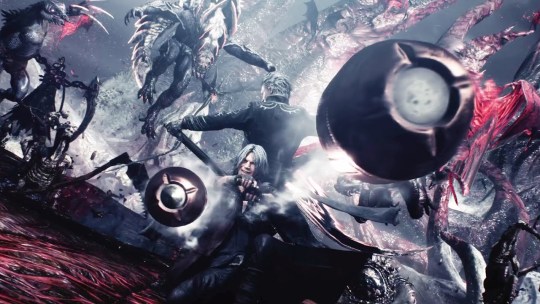
“Jackpot!”
5) Conclusion- Devils Never Cry
While it likely will never be listed as a primary reason for the character’s critical acclaim in favor of his charm or bombastic personality, Dante’s character arc across the Devil May Cry series is an overall well-written arc of a character, and this is complemented extraordinarily well by Vergil serving as his rival in two of the games. Despite only physically appearing in 60% of the numbered games canonically, Vergil has a huge role on Dante’s life, starting when they were barely children before traumatic circumstances separated them. Then when they met on the tower when they were just 19, Vergil humiliated Dante and forced him to embrace his demonic heritage so he could keep up with Vergil in a straight fight. Ultimately though, while also maturing as a person, Dante not only fought Vergil to a standstill but went on to defeat him in a straight fight. But Vergil’s deaht would haunt Dante for years to come, and that misery would intensify upon fighting and killing Nelo Angelo, driving Dante into a deep depression that lasted years until Nero reignited the spark in Dante and brought him back from the brink. Through Nero, Dante regained his purpose and drive, and when Vergil threatened to come back as Urizen and then as himself, Dante was swift to try and destroy this at the root- Vergil had upended his life and mental state twice already and he refused to let it happen a third time. It took Nero moving past his own trauma and literally bitch-slapping sense into him for Dante and Vergil to begin to reconcile, and by the time of their final scene, the two brothers are now finally united as a demon-slaying team that will last the ages. Itsuno not only saved Devil May Cry (from himself, but again, four months) after DMC 2, but retroactively tied the first two games together with the third and subsequent games to give Dante a (largely) coherent character arc across the series. For that, Itsuno and writing team, along with Reuben Langdom, deserve massive respect for accomplishing what many wouldn’t consider doing for a “dumb Japanese action game.” To say nothing of the work done to turn Vergil from a one-note villain in DMC 1 to one of the greatest rival characters in gaming, and particular praise must be given to Dan Southworth for his work as the character over the last decade. Character content like this is what will ensure that Devil May Cry as a series stays relevant not just because of its near-perfect gameplay, but its surprisingly touching character moments between these goofballs that makes me always eager for more adventures in this universe.
Thank you for reading.
(also who expected the Subhuman redux to be so good? All it took was getting rid of the kid-touching creep and getting an actual musician in the book, who’d have thunk it)
#devil may cry#dante devil may cry#vergil devil may cry#devil may cry analysis#devil may cry 5#dante#vergil#nero#nero devil may cry#devil may cry 2#devil may cry 3#devil may cry 4#devil may cry the animated series#reuben langdon#dan southworth#hideaki itsuno
73 notes
·
View notes
Text
A YEAR OF READING ACKNOWLEDGED MASTERPIECES #3: E.C. SEGAR’S POPEYE
So, while the original idea behind this series was for me to read an acclaimed comic I expect I’ll like but had not yet actually read, or to read something I’d read a little of but not its entirety, covering E.C. Segar’s Popeye is something of a cheat. When Fantagraphics began their reprint series, a roommate had the first volume, of what would eventually be six, and I read that; I later ordered my own copy of volume 3, and I own a copy of The Smithsonian Collection Of Newspaper Comics, which reprints the “Plunder Island” series of Sunday strips covered in volume 4. I enjoyed all of it, but didn’t feel a pressing need to acquire more, and now Volumes 4 and 5 are out of print and command high prices on the secondary market. This motivated me to get a copy of the still-available volume 6, which might seem less appealing because it’s the last stuff Segar did before he died, and health issues led there to be periods of time where the strip was entrusted to his assistants, in sequences not included.
The editors say those strips aren’t good, I’ll take their word for it. Other people have tried to sell other Popeye product, and I’m sure some of it is quite good: There are some people who take pains to point out that the Segar comic strips are not similar to the Fleischer brothers cartoons, but I’m sure those cartoons are good fun, I generally like the stuff that studio produced. I have seen the 1980 Robert Altman movie, starring Robin Williams and Shelley Duvall, with a screenplay by Jules Feiffer and songs by Harry Nilsson, which is a notorious flop, but with some admirers: Still, it’s a slog, which the comic strip never is. IDW’s comic strip reprint line put out books collection the late eighties/early nineties run of former underground cartoonist Bobby London, what I’ve read of that stuff (just previews online) is unfunny garbage. I think they also were behind reprints of comic books by Bud Sagendorf, and a revival written by Roger Langridge, neither of which I’ve read, though Langridge’s work is always ok; good enough for me to think it’s good, not compelling or transcendent enough for me to spend money on it. It’s all work done by those who have rights to the license, which makes me view it as essentially merchandise, like a pinball game or something. The Segar stuff is where it all comes from.
While other masterpieces of the first half of the twentieth century comics page, like George Herriman’s Krazy Kat or Winsor McKay’s Little Nemo are definitely acquired tastes, Popeye was not only popular enough to make its creator a rich man back in the day, it remains functional as populist entertainment today. I feel pretty “what’s not to like?” about it, and would recommend it to whoever. It’s funny, the characters are good, there’s adventures. The humor is three quarters sitcom style character work and one quarter the sort of silliness that verges on absurdism.
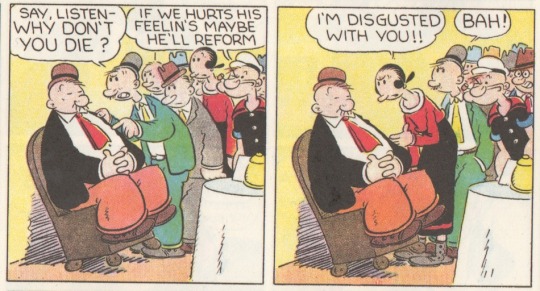
This light touch separates it from the first half of the twentieth century’s “adventure strips” that didn’t age as well, despite having well-done art that would influence generations of superhero artists. Segar’s art isn’t particularly impressive, but every strip tells a joke or two, and even if you don’t laugh at every joke, you’ll appreciate its readability, especially if you’ve ever tried to read a Roy Crane comic, or even Chester Gould’s Dick Tracy. I don’t want to praise E.C. Segar by merely listing works his comics read better than, but it really is notable how many people today are basically trying to do what he did, but are failing at least in part due to not understanding that’s what they’re trying to do. If you want to do a comedic adventure story that becomes popular enough for you to be financially successful, it might be worth reading a volume of Popeye and observing its rhythms. When I was reviewing Perdy a few weeks ago, I was thinking “This basically just wants to be a R-rated Popeye.” I recently found 3/4 of the issues of the Troy Nixey-drawn comic Vinegar Teeth for a quarter each; despite that comic’s high-concept pitch involving Lovecraftian monsters, it would probably have been better if it thought of itself as being a descendant of Popeye, rather than something that could be adapted into a movie. I’ll just phrase it in the format of a popular Twitter meme: Some of you have never read Popeye, and it shows.
Lesson number one, which just sort of emerges naturally from the format of the daily strip, is you’ve got to make jokes, and they can’t just be the same one, over and over again. To that end, you need a cast of characters, who each have their own bit, and who play off each other in various ways. It is easy to see why people don’t do this: Large ensembles grow organically, and most people start telling a story with either a central character or something precisely in mind they want to chronicle. The comic strip, with its long runs originating from a practitioner’s ability to tell a joke, can be a bit freer to stumble onto something that works, without even necessarily having a title character to return to. The collections might be named after Popeye, but the comic strip being collected in these books was called Thimble Theater, which ran for a decade before Popeye showed up and circulation sky-rocketed. For a while, I think the consensus on the early stuff was it was pretty boring and hard to read before Popeye came in and livened the whole thing up, but recently there was a reprint of this earlier material, and I know the dude who reviewed it for The Comics Journal liked it, though I’m sure it’s easy to find someone at The Comics Journal who will like an old comic strip even if it’s bad. Either way, modern cartoonists don’t have Segar’s luxury, or having their work run for a half-disinterested audience until something clicks so much word spreads.
The gag-a-day pace, built around getting into new situations and adventures, itself creates a pressure to be inventive today’s graphic novelists can’t really match. After Popeye is established as a good character, prone to getting into scrapes, Segar can show us the comedy of him caring for a baby. He can also introduce Popeye’s dad, Poopdeck Pappy, that this character looks basically exactly like Popeye but is a piece of shit is a funny idea that would not occur in the early days of planning a project.
One reason why you wouldn’t necessarily do such a design choice is because, if you’re thinking of different media as a way to success, having characters with the exact same silhouette runs counter to the generally accepted rules of animation. Thimble Theatre, as per its name, is based on theater staging, rather than the more expressionist angles of film: We’re looking at characters from the side, usually seeing whoever’s talking in the same panel unless one of them is out of the room. These characters tend to have the same height, basically. Someone once said that looking at Popeye, printed six strips to a page, is kind of like looking at a page of sheet music. It’s not a particularly visually dynamic strip, the amount of black and white on a page is close to unvarying.
This is why I don’t believe in prescriptivism, or a suggestion of rules: I’m pretty sure that Popeye works because it’s not working super-hard to be visually interesting. This would be the number two lesson of what there is to learn from Popeye. I think this transparency in style is what allows this comedy/adventure hybrid to work, though I know others would blanch at this. It’s going for a big audience, and while I think this visual approach serves that end, I know why others, especially those who’ve been struck by later superhero comics or manga, would see visual excitement as the best way to achieve that goal. The audience that read newspaper comics wasn’t necessarily adept at following visual storytelling, and the sort of relationship that newspaper strips could have with a wider readership is not going to be achievable now. The folks that ride for Segar these days are mostly alt-comics people, like Sammy Harkham or Kevin Huizenga, who aren’t attempting the sort of popular entertainment extravaganzas he trafficked in.
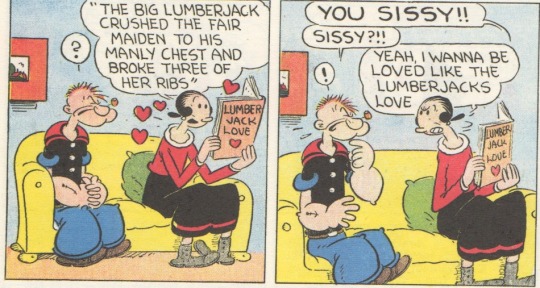
Reading Popeye feels like reading, basically, which is a nice, contemplative experience, that not all comics can capture. I read a few pages of it before bed. Obviously, this pace is not how people consumed it in its heyday, but the pace people took it in at, a strip a day, is even more deliberate and steady, and I think, was crucial to its popularity. For a comic to be popular, it has to have characters that are interesting, obviously; there is probably no better way for an audience to build a relationship with fictional characters than over extended periods of time. This speed corresponds to the pace it was created at, one that now seems insanely luxurious to anyone whose workflow is dictated by the internet’s demand for content. It’s a total crowdpleaser, but it existed at a time where crowds could slowly gather. Popeye’s a popular entertainment from an era of reading, listening to the radio, going to plays or movies. It holds up, owing to a basic pleasantness we can understand as low stakes, and that’s helped along by the restraint of the art. It’s telling a story. It’s not a farce, crowded with visual jokes, and it’s not dictated by characters’ emoting either. I love a visually expressive art style, but here it’s important that the visuals remain “on-model,” reinforcing the stability of the characterizations. This sort of thing is also evident in Chris Onstad’s Achewood, which I would argue is the preeminent 21st century character-driven comic strip, with an audience that feels relatively “wide” rather than pointedly “niche.”
Lesson number three to how to make a popular comic is the thought I find myself thinking all the time, which is “Everyone needs to chill out.” The number one impediment to making entertainment that just quietly works is the desire to stand out and make a name for yourself as quickly as possible. This is similar to how the number one impediment to a peaceful and contented life is the demands of a failing capitalism where we are all competing for a shrinking pile of resources. To read these books now is a luxury, an indulgence, and while I don’t much go in for those, reading older comic strips carries with it this sort of nostalgic appeal for an era where it didn’t feel like everything was screaming at you for your attention all the time. As broad as Popeye is, it now possesses a certain dignity, owing to this dislocation in time from its origin. I don’t know if this felt like a feature at the time. I do think that if you are an artist that wants to be successful now, you should do what you can for the sort of circumstances that allow for genuine, long-lasting success to build, which involves a certain degree of permission to fail. Mainstream comics companies, with their mentality of “we’re going to print hundreds of comics a month, in hopes some find a niche large enough to be briefly profitable we can then try to milk for their last dollar and they quickly become exhausted,” act against this. As in a garden, there needs to be space for things to take root and grow.
7 notes
·
View notes
Text
2016 Monthly Watches and Top Picks
An amalgamation of links to my personal watches and top picks, that being said there are a lot of anime I have not watched. If there is an anime that you think I should watch, recommend it to me in my Suggestions page or in the respective comments sections of my posts.
NOTE: I do not have any monthly watches or top picks from January to April, because I started this site in May of this year.
Links To My Monthly Watches (New links will be added soon)
My Monthly Top Picks
May Top Pick
Tokyo Ghoul
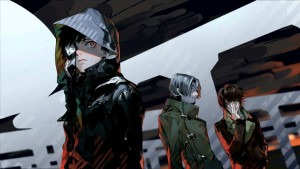
Only a few minutes before my 21st birthday I finished this series. Which means that I was an emotional wreck crying out ‘he knew!!’ while also being super excited to go out and buy my first drink; a Bloody Mary, approximately 17 minutes after officially being 21. Anyway, Tokyo Ghoul is so good. I loved it because it did not follow the path I expected it to, every event and conclusion ended up surprising me but in a good way! Without spoiling too much or going into a full review, the main character never became a ‘Mary Sue’ and the way it ended was not typical in the least. I have so many things to say but they all contain spoilers, anyway I’m glad I wasn’t deterred from the anime because one of my friends said he didn’t like the manga because of his assumption about the character. Dude, you were way off, I haven’t read the manga, but the anime is so different and so amazing. 5 out of 5 would recommend!
June Top Pick
Blue Exorcist Movie

The movie has nothing to do with the plot of the anime at all, and takes place after the events in the series. Atleast I’m fairly certain it does? There’s an important (and spoiler-y) thing that happens at the end of the series, that is never addressed or acknowledged in the movie which I think is really weird….. Either way, the movie itself is simply a completely stand alone story from the series. And it was absolutely stunning! Sooooo much detail went into all of the backgrounds and items. On top of that its very well scripted, and the plot flowed incredibly well together without being convoluted, which is surprising since a number of movie sequels to tv series’s tend to go overboard by stuffing too much information into an hour and a half.
It was amazing. Its possible that someone could watch the movie without watching the single season anime, just because of how it was written. However you would not know the relationships or the back story of the main character, which helps to explain a lot of the terminology and setting. Especially the part about demons ect ect.
Either way, I LOVED this movie. I didn’t even know that there was a movie at all until just now. I’m going to re-watch it with a friend when she gets back into town and I am soooooo excited because I KNOW she will love it too. I HIGHLY RECOMMEND IT. I RECOMMEND THIS SO HARD.
July Top Pick
Haikyuu!!
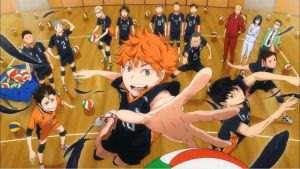
I have boarded the sports anime train, and I don't think I'm ever getting off. This is the fifth sports anime I'm watching and I think it may be my favourite. It's funny too because I only recently started watching sports anime when I watched Free! last December.
This anime is fabulous! I know I say that a lot, but it is so true! Haikyuu!! is about Hinata who joins his high school Volley ball team. The rest of the show is about the developing relationships between the team, the development of their characters and skills, and their relationships between the teams they play against as they try to make it to the Nationals.
I love so much about this anime, every character is different, has their own reasons for playing, their own personalities, their own skills, and their own developmental journey. The characters are amazing!! On top of all that the animation is great, they animate the games incredibly well, and whenever someone does something that's particularly fast or strong they do a fabulous job of showing it through the art style and movements. Ah, I could watch this show for days, well, more days than I already have. (Click the image to view the gif, cause for some reason it won't automatically play...)
Look at the smooth animation!!
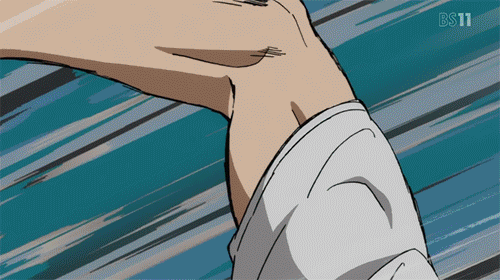
Speaking of the art style, It's different than whats common in anime, feeling a little more like a manga, but that's what makes it so great. The style allows them to make fabulous faces/expressions and movements. and Oh man the faces are great, I LOVE an anime that's able to use such a variety of expressions on so many different characters. Look at these faces!

Its such a feel good anime, its so light-hearted, and bright, and funny, and intense! There are only two season out right now, but the third season is to air this fall! I'm so excited!! so, So, SO excited!!! AAAHHHHHH~
This is a must watch. It doesn't matter what genre of anime you like, everyone should give this one a chance.
August Top Pick
Hyouka

So the first thing i need to mention is that this show is first and foremost a slcie of life that happens to include a lot of mystery. Not a mystery that happens to be a slice of life. I originally thought it was the latter which was why I was disappointed that it didn't end the series with a mystery arc, but instead the way a slice of life would.When you acknowledge the show for what it really is, a natural slice of life, it is amazing. For numerous reasons.
First the artwork is so incredibly detailed and beautiful. Second the visuals are distinctly different for each thing ti tries to convey, and completely succeeds in doing so. The audio is amazing, the music is beautiful, the animation is so smooth and they even animate things that aren't necessary to the plot but are animated anyway to make it all feel so REAL. Not to mention the episodes and mysteries are so well written!
look at the incredible amount of detail they put into EVERY SINGLE SCENE.
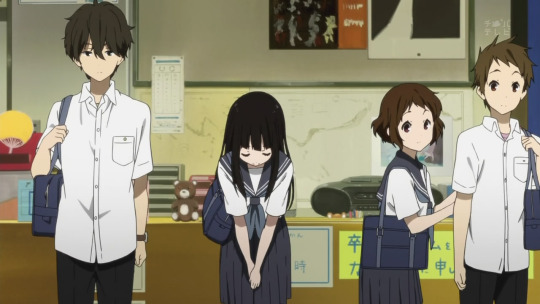
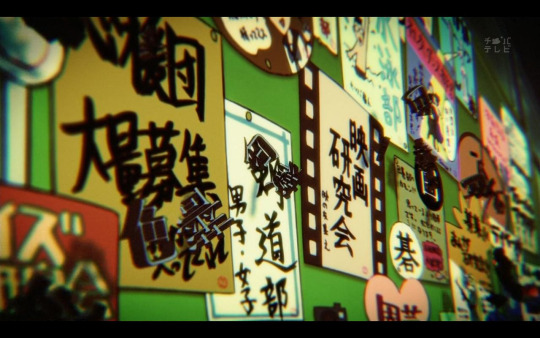
even when the background is blurred even people who we never learn about or see again have details in their clothes, faces, and expressions. I checked, we NEVER see these people below actually interact with the main OR minor cast.

I almost forgot, this show is about Houtarou a high schooler that sees the world in 'gray'and whose motto is "If I don't have to do it, I won't. If I have to do it, I'll make it quick." Convinced by his already graduated sister, he joins the classics club which was endangered to be disbanded because there were no more members. He meets a girl named Eru who also joins the club and discovers that he has a knack for solving mysteries. That is, only when Eru earnestly goes to him and yearns for him to solve the mystery because her curiosity cannot be contained. From there they quickly discover that the classics club has a past shrouded in mystery.
Its incredibly well done, I love slow the pacing myself, because it fits the flow and nature of the anime. However I do have a number of issues with it myself (some reveal content spoilers so I won't state those here). I admit that the way they ordered large mystery arch and single episode mysteries was not handled well at the very end. Don't get me wrong the ending fit the characters incredibly well and was very good and realistic, however considering the quality of the larger mysteries that were prevalent through the rest of the anime, I feel that they should have ended the series with a multi-episode arc and then one final single episode arc, rather than many single episode arcs strung together. The anime was an adaptation of a light novel, which covered 4 out of the 5 published novels. I've taken a look at the titles of the chapters and it seems that the 5th book is quite the elaborate story. One I would have liked to have seen in the anime, though would clearly have gone over the 22 episodes the anime ended at. Perhaps since this write up for the episode is already so long, I will create a post just about this anime. It definitely deserves more talking about!
Anyway, I do recommend it to veteran-ed anime watchers. It has a wonderful pace that does not push by quickly, great character development and insight, and fascinating mysteries and dialogue regarding such. Its perfect for anyone who loves natural slice of life. Those who enjoy mysteries would also enjoy this, as long as they understand that it is mostly a slice of life, and thus will follow the format of slice of life and not the format of a mystery anime. Its a stunning anime.
September Top Pick
Natsume's Book of Friends
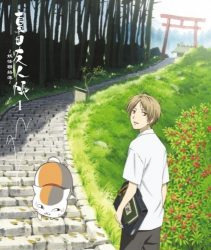
This is an incredibly adorable show. Its heartwarming and has a 'feel good' movie feel to it. If anything taking into account the art style and how good it makes you feel it reminds me a lot of Fruits Basket. Don't get me wrong, its nothing like Fruits Basket in terms of story, but its got the same 'feel'.... if that makes sense.
Anyway, the premise is that Natsume is the only one able to see yokai (Japanese monsters/spirits/gods). After moving into a new town with some distant relatives, Natsume finds out that is deceased grandmother could also see yokai and made quite the reputation among them. She would take the names of local yokai and put it into a book called the book of friends, with their names she could control the yokai. Now yokai are coming after Natsume either to ask him to return their names or to take the book of friends for themselves.
The majority of the show is about Natsume steadily coming to understand both humans and yokai more clearly than he has before. Making friends, learning about the lives of others, learning about his grandmother, and finding out what it really means to be apart of a family and not be ostracized by others because of his ability.
This show is wonderful, its not as gripping or super emotion/action driven as some other shows are, but its very well done. The character are great, the stories are so heartwarming, and it breaks a number of the stereotypical cliches that are often found with anime about a character who can see something that others cannot. An example that I particularly love is how other characters who come into the mix who are also able to see yokai are not automatically 'evil' or an antagonist. So rather than causing mroe trouble for Natsume from the 'get go' they are actually there to help develop him into a better character. Which I love~ Any actual antagonist that shows up are antagonists for a real reason, rather than just for the purpose of having one.
If your into exorcism anime or anime that focuses on traditional Japanese monsters/spirits/gods you will love this one. It is slower paced and focuses more on story than action so keep that in mind. Also keep in mind that there are only 4 season out right now as of this post. Season 5 will be coming out with this falls simulcasts and I'm super excited for it
#2016#msma 2016#haikyuu!!#hyouka#natsume yuujinchou#natsume's book of friends#blue excorsist#blue exorsict movie#tokyo ghoul#msma monthly watch
2 notes
·
View notes
Text
"Juni Taisen: Zodiac War" Book Review and Comparison
Popular anime series often see a bit of a lag before their source material gets released in English translation, so we're very lucky Viz released the original light novel of Juni Taisen: Zodiac War just two weeks into the anime's broadcast. I picked up the novel on the release date, so I had my introduction to NisiOisin's quirky battle royale through the anime, but I've already completed the story in the novel. It's fascinating to compare the strengths of both versions.
Today, we'll be reviewing Viz Media's translation of the novel, as well as comparing the novel with the first six episodes of the anime. And don't worry, we won't be spoiling the anime!
Reviewing the Juni Taisen Novel
Juni Taisen: Zodiac War is a light novel originally published in 2015 as a prequel to a one-shot manga collaboration between author NisiOisin and illustrator and mangaka Hikaru Nakamura. Isin is the infamous author of the Monogatari series, while Hikaru Nakamura is best known as the creator of cult series Arakawa Under the Bridge and Saint Young Men. The plot concerns the titular Zodiac War, a mysterious battle royale held by a secret society every twelve years, with the prize being a single prize: Any wish. The combatants are themed after the animals of the Chinese zodiac, with attacks, personality traits, and histories that riff off this important cultural touchstone. The premise seems to combine two fairly overdone stock anime plots, but NisiOisin is known for his self-aware genre knowledge and willingness to play with the rules. Juni Taisen: Zodiac War is a fantastic example of this with characters who all seem to upend some rule of the game, making it less a question of who will win, and more of a question of how and why.
In the novel (translated by Nathan A. Collins for Viz), the prose is very direct and to the point, helped along by the translation's decision to emphasize action and flow over getting bogged down in NisiOisin's wordplay (the groan-inducing puns in characters' names are left to a helpful appendix). NisiOisin has only a few flights of fancy (he is still NisiOisin, after all), with most of the action told in third person narration by one character at a time. Being a story of a brutal battle to the death, characters are often dispatched before they're able to be developed to a satisfying level, but the characters who do survive are often more well-rounded than those who die early on. Nisio is obsessed with personalities, so character superpowers end up causing fewer deaths than ideals and flaws. The table of contents lays out the exact order of events from the very start, there's very little surprise in who wins, and those who approach the material from that perspective will be disappointed. However, when I finished the story, knowing who the winner was from page one, I was still extremely satisfied by all of the character developments I could not predict.
On a technical note, the production of Viz's release is top notch. Unlike most Japanese novel releases, Juni Taisen is given a hardcover with dust jacket, ornate red and gold title pages, and sturdy paper. If you enjoy the anime, or are willing to try a more quick, brutal, and direct work from NisiOisin, I greatly recommend the book. Those looking for a deeply character driven world like Monogatari won't find it here. I will now discuss how the anime chose to adapt the series through episode 6, so spoiler warning below.
Novel versus Anime
Who wasn't awed by Juni Taisen's first episode, where Boar takes all of the abuse she's received from her parents and turns it on her poor younger sister, becoming an even more monstrous version of her father? What's most amazing about this episode is that this story is not in the book. Amazingly, all of the background information of each fighter is told in a textbox listing their biographical details, while the prose of the novel takes place entirely during the Zodiac War. Boar's entire scheme in the anime was taken from the line, "Originally her sister, five years her elder, had earned the right to participate in the Twelfth Zodiac War, but in culmination of a twelve-year plot, Toshiko killed her sister and claimed the invitation for herself." Perhaps the story came from notes NisiOisin provided to the man doing the adaptation, Sadayuki Murai, but Murai's own resume includes writing Perfect Blue, Millennium Actress, Kino's Journey, and other classics. Changing the older sister to a younger one may have been entirely his idea.
The book has 12 main sections, which track perfectly to twelve episodes, the usual length of an anime series. The first three episodes – Boar, Dog, and Chicken – are adapted pretty much straight from the book. The Zodiac War material from Boar's chapter would not fill a full episode, so her backstory was fleshed out a great deal. Poor Dog had a lot happen during his battle, so his life as a calligraphy buff and daycare teacher was left sadly unexplored. Chicken had perhaps the best mix, with an equal amount of backstory and confrontation, giving her a full character arc.
By this point, a pattern had been identified, so the anime decided to shake it up, allowing events that happened simultaneously occur to all characters at the same time, allowing more tension and suspense to build. The stories of Monkey, Sheep, and Horse blended elements from the fourth, fifth, and sixth chapters into the ideal battle flow, while still expanding upon their backstories. Monkey's peace treaty, a touching scene equal to Boar's magnum opus of violence, was also anime original.
The anime adaptation does have some drawbacks. On many occasions, characters will talk and think at the same time, leading to two sets of subtitles onscreen. The book, with no time pressures, doesn't have this compression problem. Nisio's beloved linguistic trickery is also largely absent from the anime, with its focus on action, and many small clever details, like Sheep's mobage addiction, are dropped for sake of time.
It's fascinating to compare how the different versions of Juni Taisen try and take advantage of the strengths of their medium. If you're a fan of the series, I recommend following along on the next six episodes and seeing how they're adapted.
Review Roundup (Novel)
+ Great production on study hardcover book
+ Exciting, twisted subversion of battle royale series by too-clever-by-half NisiOisin
- Your favorite character gets killed off too soon
- Hectic battle format precludes deep character development or worldbuilding
---
Thomas Zoth is a features writer for Crunchyroll, blogs occasionally at Hungry Bug Diner, and appears on podcasts at Infinite Rainy Day. You can follow him on twitter at @ABCBTom.
0 notes
Text
post-post colonial
cant remember if i posted this when i did it.... and if i did, here it is again haha my post post-colonial essay
Joshua Thompson
Post Post-colonial
Artifact I like and think is good.
Air Max One
The Nike Air Max One is a sneaker designed and released in 1987 by legendary sneaker designer, Tinker Hatfield. On a trip to paris, Hatfield was inspired by the Centre Georges Pompidou (Longville & Hatfield, 2006). A building which is cutting edge in it's own right. Hatfield liked the idea that you could see the inner workings of the buildings structure, from the outside(Longville & Hatfield, 2006). This inspired him to incorporate the window in the sole of the air max one, letting you see the inner workings of the signature air sole. This is a feature that would continue on and become one of Nikes' greatest and most recognizable design features even to this day. Hatfield says
Every shoe I design has to have a story behind it, that's what everybody falls for – be it the history of the shoe, the cultural relevance, or the technology, whether that's being excited about the latest technology of the latest design like flywire or reminiscing about the technology of the Air Max for example(The guardian, 2014).
The Narrative of this sneaker though, could not have been predicted by Hatfield. What made this shoe revolutionary and ahead of it's time was that because of the make of the panels, and it's already radical yet simple design, Nike could afford to continuously re-colour the Air Max and introduce new iterations of it constantly(The Guardian, 2014). This combined with it's hefty price tag, made the sneaker somewhat of a cultural phenomenon, especially in the Hip-hop community(Complex, 2015). This is Illustrated by numerous rappers making reference to the Air Max in songs, such as the Game threatening to “kill you if you try me for my Air Max 95s” in his song Hate it or Love it. Also due to its high price tag and cult status in the hip-hop community, the shoe became a target for crime. In the UK, the Air Max 95 has long held some criminal associations. The Air Max's' large price tag affords it a certain status, and its footprint has been commonly spotted at crime scenes. According to a forensic science report from the mid-2000s, the 95 was trailing second in “typical pattern frequency distribution for footwear marks from a UK police force” at just 8% to the 10% of Marshall Mathers’ favorite sneaker, the Air Max LTD(Complex 2015).
The sneaker also has a huge following in Japan, making appearances in numerous manga and anime series after the Japanese appetite for dead stock, second hand sneakers which have not been worn, grew dramatically in response the re-release of the Air Max(Complex, 2015).
These things show evidence of the globalized nature of fashion and design today, in which slippage and appropriation occurs and new meaning is ascribed to and artifact.The fact that this sneaker remains one of the most popular sneakers among youth today, despite being a 30 year old design, and that the high resale price of the sneakers is driven solely by the quality and design of the shoe, as opposed to just limited supply (which is how other shoes on this list garner their high prices), is why I the Air Max is one of favourite pieces of design.
Artifact I don't like and think is good.
Nike Air Mag
The Air Mag was also designed by Tinker Hatfield. This sneaker was designed for the film Back to the future Part II. Hatfield designed the sneaker for the movies release in 1989, in which Marty McFly time travels to the year 2015 where, among other things, he encounters these shoes. They were Hatfield's attempt at predicting a shoe that would be helpful and functional for people of that time. These shoes are a great piece of design because of the sheer influence they have had on almost every nike release since then, and also some other brands (complex, 2015).
One of the most intriguing aspects of the nike mag, is that for twenty six years, they were merely a design. They were not released to the public, or even made (apart from the pairs used for filming) until 2011 when they released a sort of look alike version, and then the full release of the adaptive lacing full version in 2015 (complex, 2015). This was for a number of reasons, the most notable is because the technology simply could not be fit into a shoes the that size, as the design of it is meant to fit snugly around the wearers foot (highsnobiety, 2015), an idea which at the time was un heard of but is now evident on most popular designs today such as Nikes' huaraches, and Adidas' NMD and ultra boost lines.
The Air Mag also pioneered the technology which would become Hyperwire. Nikes technology which would revolutionize performance basketball shoes from 2008 onwards (complex, 2015).
It was also a huge contributor to the design of Kanye Wests Nike Yeezy line, lending its extremely high over the ankle design and the use of a lycra or synthetic inner sole. The shoe spanned only two models, but became somewhat of a cult icon due to it's limited stock releases.
Despite the critical and commercial success of these shoes, I do not think that they are good sneakers. This is partly because in the film, they are advertised as being mass produced, and everyone was wearing them, however when they were released, they were only done so at auction, with a very limited run, meaning that prices went into the thousands of dollars immediately, and although the proceeds went towards Michael J. Fox' Parkinson's research foundation, it made it almost impossible for people to afford. The cultural impact of the Nike air mag is undeniable, but the design of the shoes is clunky and although it spawned a number of game changing technologies, it feels somewhat un-authentic, and the value of the sneaker is almost fetishized by the nostalgia they evoke.
Artifact I don't like and don't think is good.
Adidas Yeezy Boost 750
Kanye West leave Nike and join Adidas after the release of the Yeezy 2, citing that Nike would not allow him as much creative freedom as he was looking for. For my opinion, this was a good call by Nike as I feel that the Yeezy Boost lines are lazily designed and only enjoy the status that they do among the sneaker community due to the brand he has created and his insistence on releasing only very limited numbers of shoes at a time, forcing people to wait in lines outside sneaker stores for sometimes days on end. This principle of lazy design is evident in all of Kanye's' design, evidenced by a plain white T-shirt he released in collaboration with APC, which retailed and sold out, for $120 USD (okay player, 2013).
Kanye west raps about racism and the exploitation of black people in many of his songs, such as Breathe in breathe out and Spaceship, then actively markets extremely expensive products to those people, knowing full well that his brand and star power will create demand among people who often can't afford these shoes. Sneaker production costs are notoriously low, across the board, in comparison to their recommended retail price, with the Yeezy boost 750 being no exception. The shoes costs around $76 USD to make and retails for $350 USD, however (Highsnobiety, 2016), the dead stock resale value of the 750s' can exceed $1500 USD.
Another factor which sets these apart from other sneakers that can sometimes garner similar price increases, is that others such as Air Jordan Retros and Air Max sneakers, all have functional origins. The sneakers are designed to be use full and have a practical application, Whereas the Yeezy 750s' do not. They are made specifically for fashion, and are despite attempts by some nbaplayers, are not suitable for playing sports in, I can attest to this as I was gifted a pair and they promptly ripped and I hurt my ankles.
These Shoes are a prime example of ascribed value and The difficulties of existing in an hybrid space as an artist or designer. It is an example of the oppressed becoming the oppressor and the oppressed no longer being fully able to see themselves without the gaze of the colonizer.
Artifact that I like but suspect might not be good
Air Jordan 1
The original Air Jordan 1 is one of the most legendary sneakers in the world. Released in 1985 for $65 USD, they were designed for and worn by Michael Jordan for his rookie season. They were ground breaking in that they were the first shoe to be worn in the NBA featuring more than one colour. This at the time, broke NBA commissioner David Sterns strict uniform policy and he fined Jordan $5000 USD per game every time he wore them “Nike loved this idea so much that they encouraged MJ to wear the shoes, and Nike would pay the fees. In result, Nike gave the the Air Jordan 1 “The shoe banned by the NBA” label” (sneakerfiles).
This gave the Air Jordan 1 a cult following and it became the most popular sneaker of the decade (sneaker files), and forced David Stern to change his Uniform policy. The shoe also spawned many impersonators, including the Converse weapon and the Reebok Pump. However, The Air Jordan itself was in impersonator. It was modeled after the Air Force 1, released in 1982. This shoes has a very similar design, and employs the same technology but was discontinued in 1984, and seemingly released under a different name as the Air Jordan the next year (complex, 2012).
The fact that it is basically the same shoe with a different name, and today an almost $100 NZD price difference, Is why I think that they it may not be a great sneaker. They are merely a product of Nikes great marketing. Also, while there is apparent similarities between the Air Jordan sneakers chronologically, this doesn't apply to the Air Jordan 1. The Air Jordan 2 is a completely different sneaker. The Air Force 1 went on to become the highest selling athletic shoe of all time (complex, 2012), and the Air Jordan 1 is one of the least frequently released of the Air Jordon retro collection.
Despite this, the cult status of the shoe, and its' classic red, black and white colour way, are one of my favourite sneakers of all time, as are the Air Force one. They have their own mythology about them, and this narrative is the main selling point, despite the design of the sneaker itself being quite unoriginal.
Reference List
Complex (2015, September 11), 20 things you didn't know about the air max 95, retrieved from
http://au.complex.com/sneakers/20-things-you-didnt-know-about-nike-air-max-95/
Complex (2012), 30 things you didn't know about the air force 1, Retrieved from http://au.complex.com/sneakers/2012/12/30-things-you-didnt-know-about-the-nike-air- force-1/original-was-discontinued
Complex (2015, October 24), The visible influence of the nike mag on sneakers in 2015, retrieved from http://au.complex.com/sneakers/2015/10/nike-air-mag-modern-sneaker-influence
Highsnobiety (2015) Fiction to fact : Tinker Hatfield explains how adaptive lacing was made for the nike mag. Retrieved from http://www.highsnobiety.com/2016/10/06/nike-mag-adaptive-l acing-tinker-hatfield-video/
Highsnobiety (2016), Sneaker production costs, Retrieved from http://www.highsnobiety.com/2016/05/27/sneaker-production-costs/
Nice Kicks (2015) Nike air mag, retrieved from http://www.nicekicks.com/tag/nike-air-mag/
Okay player (2013) Not Okay, Player: Kanye West's $120 Plain White "Hiphop" T-Shirt Sells Out Instantly. Retrieved from http://www.okayplayer.com/news/style-kanye-west-apc-120-plain- white-hiphop-t-shirt-sells-out.html
Sneaker freaker (n.d.), Air max 1, retrieved from https://www.sneakerfreaker.com/tag/air-max-1/
Sole Collector (2015, May 24), How to Buy the 'Chicago' Air Jordan 1 on Nikestore
Retrieved from https://solecollector.com/news/2015/05/air-jordan-1-chicago
Thibaut de Longeville, Tinker Hatfield (2006, September 6), Respect the architects, Retrieved from
https://vimeo.com/38994002
The Guardian (2013, December 14), Nike's iconic air max trainer celebrates 25th anniversary with Tinker Hatfield. Retrieved from https://www.theguardian.com/fashion/2013/dec/14/nike-air- max-trainer-25-anniversary-tinker-hatfield
0 notes